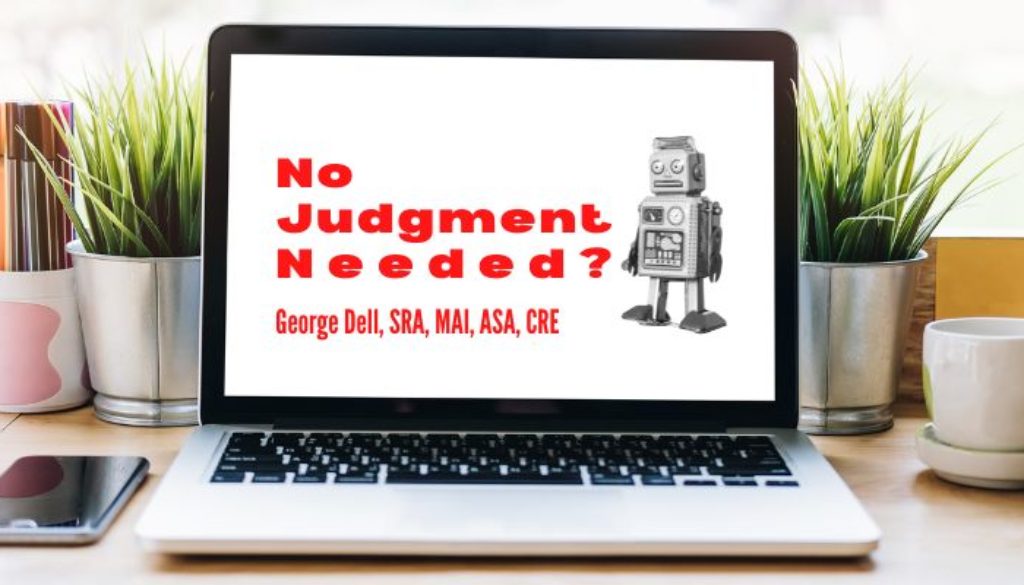Judgment in valuation analysis is not needed — so they say — so long as the algorithm is right.
So long as the algorithm is right . . .
For appraisers, this means the valuer has identified a good scope of work. For a researcher, this means an investigation path is identified – a hypothesis.
But what about AVMs?
An AVM is an “automated” model. In theory, this means that no human intervention is needed. No one needs to go visit the property. No one needs to decide the AVM algorithm is enough. No one needs to worry about scope of work. And no one needs to decide whether the result is “sufficient” for the loan risk involved. Best of all, AVMs will also even tell you how reliable the result is. (Determined by an automated, but secret algorithm.)
But wait! Is anything in the above paragraph true? Really true?
Let’s look:
- Someone has to decide what is the property type and what are its key features.
- Someone has to decide the chosen AVM’s algorithm is appropriate for this property.
- Someone has to make the decision the data is relevant (or good-enough) for this analysis.
For an appraisal, an appraiser makes those decisions. For an ‘evaluation’ exception, the evaluator makes those decisions. And what about AVM decisions? Let’s look:
- The property type is decided (determined) by the client or loan officer.
- The appropriateness of the secret algorithm is judged by the client.
- The data relevance is predetermined by the AVM programmer.
It appears that judgment is required at each step! What matters is who makes the judgment, a judgment to the decision – at each step:
- Problem identification
- Solution algorithm
- Data needed
One of the conclusions of recent investigation about possible AVM industry standards is clear. Any standard requires delineation of practice in three areas: 1) problem definition (assumptions); 2) data selection; and 3) algorithm to be applied. A fourth follow-on concept is that a consistent method of measuring reliability is required. Risk cannot be measured without measured reliability of individual valuations, regardless of who performs and who decides.
The main point here is that individual AVMs are black boxes, including the measurement of risk. AVMs are an industry, not an algorithm!
Contrarily, appraisals (and ‘evaluations’) are of grey brain putty, also not possible to judge objectively.
What is needed is integration of sharpened expert judgment with computer power. A blend of skilled modeling and computational algorithmic logic.
We need transparency and reproducibility. And nothing less for the public trust!

June 15, 2022 @ 7:54 am
Lenders make money from the fees charged to make the loans and the interest received. Companies that are publicly traded, can enhance their stock price most by increasing their fee income.
Management bonuses are largely tied to increased stock prices. The faster loans can be booked, the more fee income there is and stock prices go up.
Having a valuation product that “Looks Good”, is acceptable in the secondary mortgage market, (GSE’s and other MBS investors) and getting it quickly may drive many lenders behaviors.
On the front end, appraisers are pushed to go fast and work cheap. Then, often their work product is suspect. In this arena, there is no time for the appraiser to take the due diligence steps as defined in the appraisal process. Grabbing raw data from 3rd party vendor sources and using it at face value is the usual and customary procedure for tens of thousands.
All the sins of the appraiser are covered up when markets are rising and they become exposed once they decline. Professional liability lawsuits increase within a year or two after markets start declining.
Often times lenders will get a waterfall of AVM’s quickly and then decide how reliable they are or aren’t; before they order an appraisal. If the decision is made that the AVM is good enough, reliable enough; no appraisal is ordered.
Meaning, appraisals are ordered more often on high risk loans, those with small down payments and/or when the borrower has blemished credit . Or they are ordered when the property is non-conforming or in a non-conforming area.
For me, this means I would need to exercise more due diligence in verifying things about the subject and the market data being relied upon, which takes times and a larger fee. Nether of which lenders want.
When they are willing to pay is often only after a loan default and the legal department or outside counsel hires the forensic review appraiser. And, the beat goes on cycle after cycle. And, more often than not, the first lenders to start suing appraisers after a downturn are the ones who wanted reports faster and cheaper.
We are being played like pawns, and for the most part our industry does not realize the game they are in.
June 15, 2022 @ 11:17 am
AGREED!!!
June 17, 2022 @ 5:03 am
George. I love this post, and I could not agree more. One specific line caught my attention “What is needed is integration of sharpened expert judgment with computer power. A blend of skilled modeling and computational algorithmic logic.”
Your observation is key to appraisers maintaining our relevance. We must evolve into data and real estate analysts rather than property inspectors. The question arises, WHO is blending human judgment with computer power? What companies are driving this change? Most are interested in removing the appraiser rather than integrating human and machine intelligence.